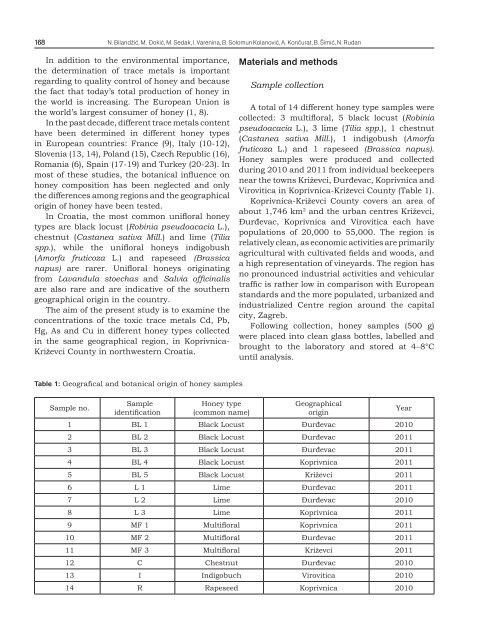SLOVENIAN VETERINARY RESEARCH
SLOVENIAN VETERINARY RESEARCH
SLOVENIAN VETERINARY RESEARCH
Create successful ePaper yourself
Turn your PDF publications into a flip-book with our unique Google optimized e-Paper software.
168<br />
N. Bilandžić, M. Ðokić, M. Sedak, I. Varenina, B. Solomun Kolanović, A. Končurat, B. Šimić, N. Rudan<br />
In addition to the environmental importance,<br />
the determination of trace metals is important<br />
regarding to quality control of honey and because<br />
the fact that today’s total production of honey in<br />
the world is increasing. The European Union is<br />
the world’s largest consumer of honey (1, 8).<br />
In the past decade, different trace metals content<br />
have been determined in different honey types<br />
in European countries: France (9), Italy (10-12),<br />
Slovenia (13, 14), Poland (15), Czech Republic (16),<br />
Romania (6), Spain (17-19) and Turkey (20-23). In<br />
most of these studies, the botanical influence on<br />
honey composition has been neglected and only<br />
the differences among regions and the geographical<br />
origin of honey have been tested.<br />
In Croatia, the most common unifloral honey<br />
types are black locust (Robinia pseudoacacia L.),<br />
chestnut (Castanea sativa Mill.) and lime (Tilia<br />
spp.), while the unifloral honeys indigobush<br />
(Amorfa fruticoza L.) and rapeseed (Brassica<br />
napus) are rarer. Unifloral honeys originating<br />
from Lavandula stoechas and Salvia officinalis<br />
are also rare and are indicative of the southern<br />
geographical origin in the country.<br />
The aim of the present study is to examine the<br />
concentrations of the toxic trace metals Cd, Pb,<br />
Hg, As and Cu in different honey types collected<br />
in the same geographical region, in Koprivnica-<br />
Križevci County in northwestern Croatia.<br />
Materials and methods<br />
Sample collection<br />
A total of 14 different honey type samples were<br />
collected: 3 multifloral, 5 black locust (Robinia<br />
pseudoacacia L.), 3 lime (Tilia spp.), 1 chestnut<br />
(Castanea sativa Mill.), 1 indigobush (Amorfa<br />
fruticoza L.) and 1 rapeseed (Brassica napus).<br />
Honey samples were produced and collected<br />
during 2010 and 2011 from individual beekeepers<br />
near the towns Križevci, Đurđevac, Koprivnica and<br />
Virovitica in Koprivnica-Križevci County (Table 1).<br />
Koprivnica-Križevci County covers an area of<br />
about 1,746 km 2 and the urban centres Križevci,<br />
Đurđevac, Koprivnica and Virovitica each have<br />
populations of 20,000 to 55,000. The region is<br />
relatively clean, as economic activities are primarily<br />
agricultural with cultivated fields and woods, and<br />
a high representation of vineyards. The region has<br />
no pronounced industrial activities and vehicular<br />
traffic is rather low in comparison with European<br />
standards and the more populated, urbanized and<br />
industrialized Centre region around the capital<br />
city, Zagreb.<br />
Following collection, honey samples (500 g)<br />
were placed into clean glass bottles, labelled and<br />
brought to the laboratory and stored at 4-8°C<br />
until analysis.<br />
Table 1: Geografical and botanical origin of honey samples<br />
Sample no.<br />
Sample<br />
identification<br />
Honey type<br />
(common name)<br />
Geographical<br />
origin<br />
1 BL 1 Black Locust Đurđevac 2010<br />
2 BL 2 Black Locust Đurđevac 2011<br />
3 BL 3 Black Locust Đurđevac 2011<br />
4 BL 4 Black Locust Koprivnica 2011<br />
5 BL 5 Black Locust Križevci 2011<br />
6 L 1 Lime Đurđevac 2011<br />
7 L 2 Lime Đurđevac 2010<br />
8 L 3 Lime Koprivnica 2011<br />
9 MF 1 Multifloral Koprivnica 2011<br />
10 MF 2 Multifloral Đurđevac 2011<br />
11 MF 3 Multifloral Križevci 2011<br />
12 C Chestnut Đurđevac 2010<br />
13 I Indigobuch Virovitica 2010<br />
14 R Rapeseed Koprivnica 2010<br />
Year

















